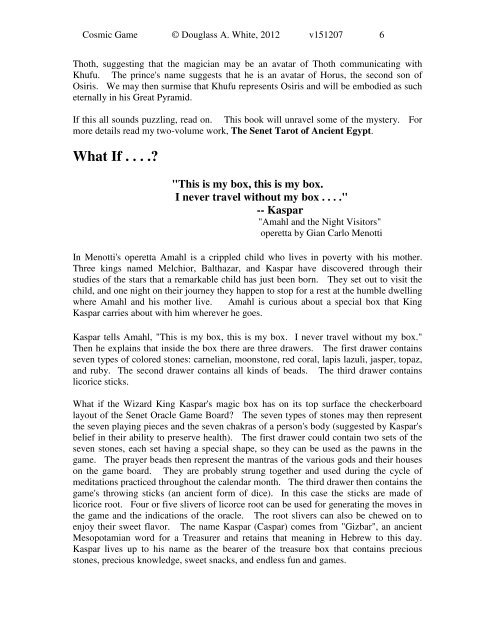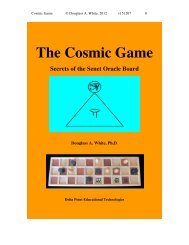Create successful ePaper yourself
Turn your PDF publications into a flip-book with our unique Google optimized e-Paper software.
<strong>Cosmic</strong> <strong>Game</strong> © Douglass A. White, 2012 v151207 6<br />
Thoth, suggesting that the magician may be an avatar of Thoth communicating with<br />
Khufu. <strong>The</strong> prince's name suggests that he is an avatar of Horus, the second son of<br />
Osiris. We may then surmise that Khufu represents Osiris and will be embodied as such<br />
eternally in his Great Pyramid.<br />
If this all sounds puzzling, read on. This book will unravel some of the mystery. For<br />
more details read my two-volume work, <strong>The</strong> Senet Tarot of Ancient Egypt.<br />
What If . . . .?<br />
"This is my box, this is my box.<br />
I never travel without my box . . . ."<br />
-- Kaspar<br />
"Amahl and the Night Visitors"<br />
operetta by Gian Carlo Menotti<br />
In Menotti's operetta Amahl is a crippled child who lives in poverty with his mother.<br />
Three kings named Melchior, Balthazar, and Kaspar have discovered through their<br />
studies of the stars that a remarkable child has just been born. <strong>The</strong>y set out to visit the<br />
child, and one night on their journey they happen to stop for a rest at the humble dwelling<br />
where Amahl and his mother live. Amahl is curious about a special box that King<br />
Kaspar carries about with him wherever he goes.<br />
Kaspar tells Amahl, "This is my box, this is my box. I never travel without my box."<br />
<strong>The</strong>n he explains that inside the box there are three drawers. <strong>The</strong> first drawer contains<br />
seven types of colored stones: carnelian, moonstone, red coral, lapis lazuli, jasper, topaz,<br />
and ruby. <strong>The</strong> second drawer contains all kinds of beads. <strong>The</strong> third drawer contains<br />
licorice sticks.<br />
What if the Wizard King Kaspar's magic box has on its top surface the checkerboard<br />
layout of the Senet Oracle <strong>Game</strong> Board? <strong>The</strong> seven types of stones may then represent<br />
the seven playing pieces and the seven chakras of a person's body (suggested by Kaspar's<br />
belief in their ability to preserve health). <strong>The</strong> first drawer could contain two sets of the<br />
seven stones, each set having a special shape, so they can be used as the pawns in the<br />
game. <strong>The</strong> prayer beads then represent the mantras of the various gods and their houses<br />
on the game board. <strong>The</strong>y are probably strung together and used during the cycle of<br />
meditations practiced throughout the calendar month. <strong>The</strong> third drawer then contains the<br />
game's throwing sticks (an ancient form of dice). In this case the sticks are made of<br />
licorice root. Four or five slivers of licorce root can be used for generating the moves in<br />
the game and the indications of the oracle. <strong>The</strong> root slivers can also be chewed on to<br />
enjoy their sweet flavor. <strong>The</strong> name Kaspar (Caspar) comes from "Gizbar", an ancient<br />
Mesopotamian word for a Treasurer and retains that meaning in Hebrew to this day.<br />
Kaspar lives up to his name as the bearer of the treasure box that contains precious<br />
stones, precious knowledge, sweet snacks, and endless fun and games.





